Ocean Signal E101V Emergency Position Indicating Radio Beacon (EPIRB) User Manual VDR 2
Ocean Signal Ltd. Emergency Position Indicating Radio Beacon (EPIRB) VDR 2
Users Manual
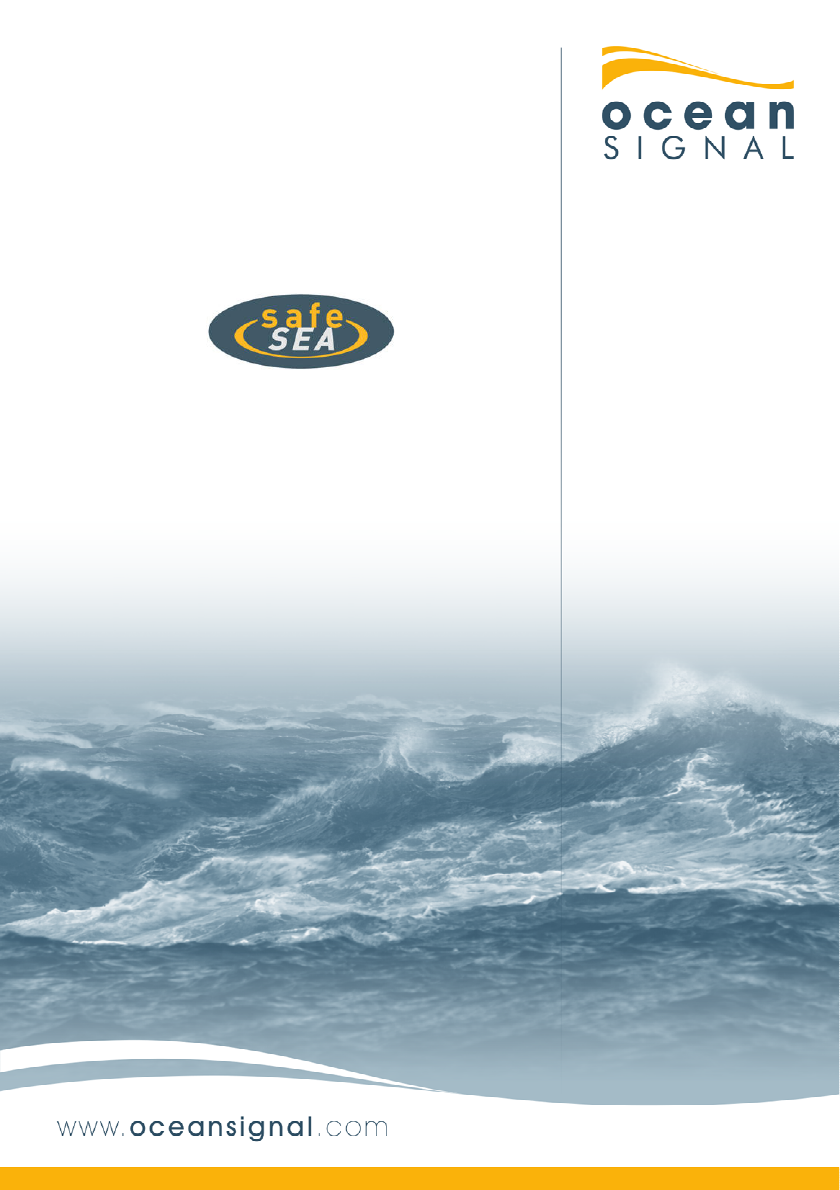
User Manual
E101V
Emergency Position
Indicating Radio Beacon
(Including Float Free VDR memory capsule)
English
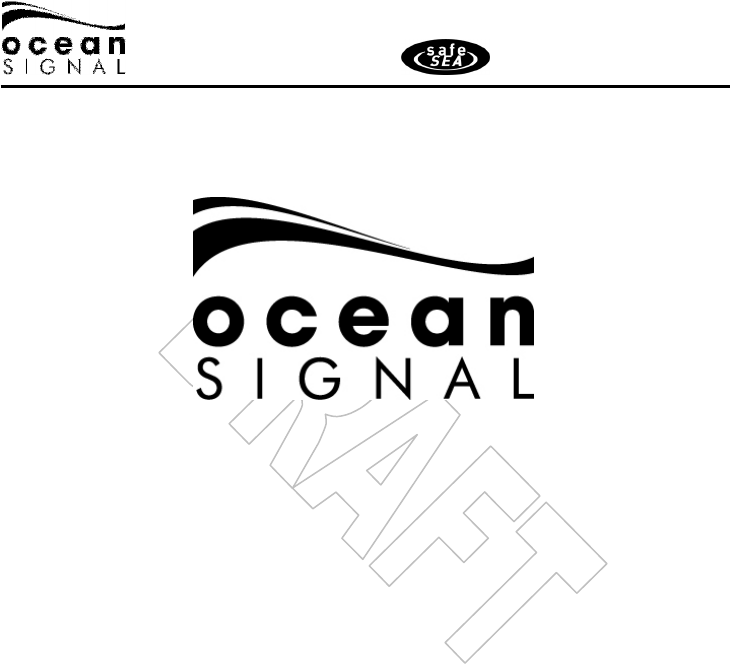
E101V USER MANUAL
2 Part No 912S-01865
© 2015 Ocean Signal Ltd
The technical data, information and illustrations contained in this manual were believed to
be correct at the time of print. Ocean Signal Ltd reserve the right to change specifications
and other information contained in this manual as part of our continual improvement
process.
No part of this manual may be reproduced, stored in a retrieval system or transmitted in
any form, electronic or otherwise, without the prior permission of Ocean Signal Ltd.
No liability can be accepted for any inaccuracies or omissions in this manual.
Ocean Signal® and rescueME® are registered trademarks of Ocean Signal Ltd.
For ease of access please record details of your EPIRB here.
Owners Name: .............................................
Vessel Name: ...............................................
Beacon HEX ID (UIN): ...................................
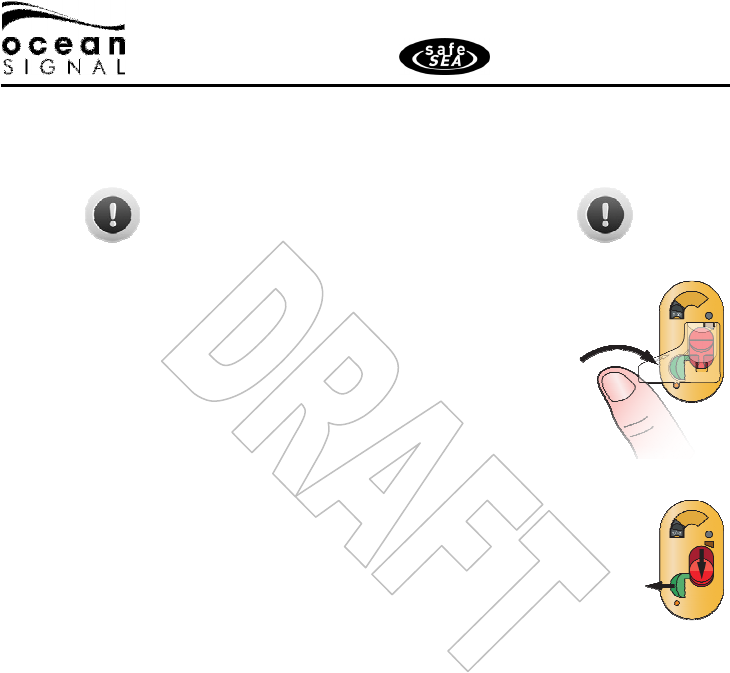
E101V USER MANUAL
3 Version 00.30 7/4/2016
IN CASE OF EMERGENCY
Use only in Situations of Grave or Imminent
Danger
• For Manual Activation
• Remove the EPIRB from the housing
• Make sure the antenna is folded out fully vertical
• Break off the protective cover
• Slide and hold the Green switch to the left, then slide the RED
switch into the down position and release the Green switch
• The green led will flash to indicate activation
• The strobe light will start flashing to indicate it is activated
• Remove the lanyard cover
• Holding the free end of the lanyard, throw the EPIRB into the water.
Refer to section 4.2 for deactivation instructions.
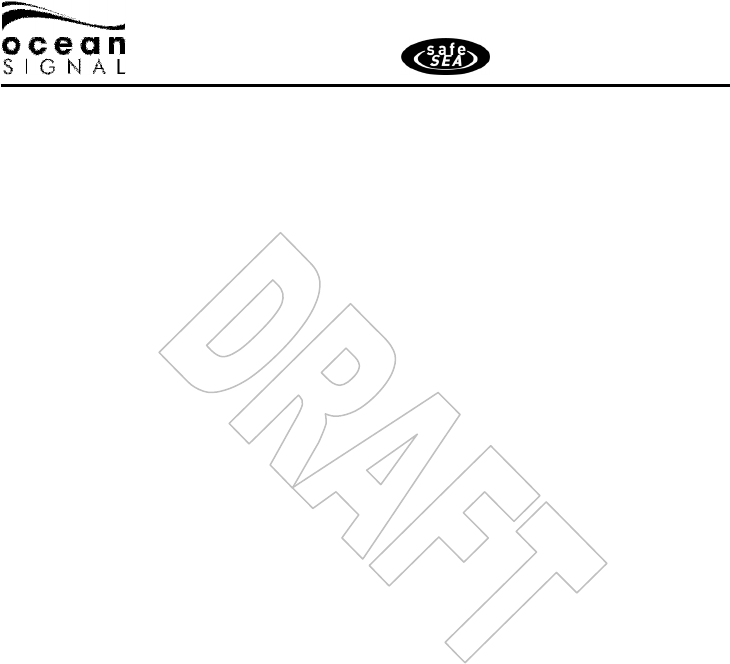
E101V USER MANUAL
4 Part No 912S-01865
CONTENTS
IN CASE OF EMERGENCY ........................................................................................................................... 3
1.
GENERAL ............................................................................................................................................ 5
1.1
Introduction .................................................................................................................. 5
1.2
Exposure to RF Electromagnetic Energy .................................................................... 5
1.3
Warnings ...................................................................................................................... 5
1.4
Operating Mode ............................................................................................................ 5
1.5
COSPAS/SARSAT System ............................................................................................ 6
2.
Installation .......................................................................................................................................... 6
2.1
VDR Installation ........................................................................................................... 7
2.2
EPIRB Installation ........................................................................................................ 8
3.
E101V OVERVIEW ................................................................................................................................ 9
4.
OPERATION .......................................................................................................................................10
4.1
Manual Release and Activation ................................................................................. 10
4.2
Deactivation................................................................................................................ 11
4.3
False Alerts ................................................................................................................ 11
5.
TESTING ............................................................................................................................................12
5.1
Beacon test ................................................................................................................ 12
5.2
GPS test ...................................................................................................................... 13
6.
APPENDIX ..........................................................................................................................................14
6.1
Maintenance and Troubleshooting ........................................................................... 14
6.2
Batteries ..................................................................................................................... 14
6.3
Transport.................................................................................................................... 14
6.4
Disposal ...................................................................................................................... 15
6.5
Specifications ............................................................................................................. 16
6.6
Approvals ................................................................................................................... 17
6.7
Registration ................................................................................................................ 17
6.8
Limited Warranty ....................................................................................................... 18
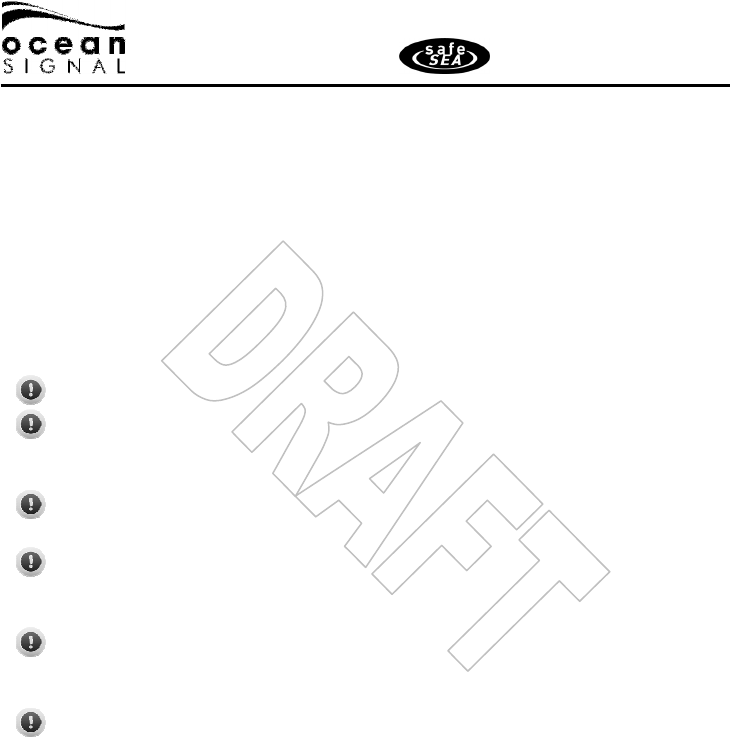
E101V USER MANUAL
5 Version 00.30 7/4/2016
1. GENERAL
1.1 Introduction
The SafeSea range of products provides the user with the latest technology specifically
designed for compact size and ease of operation. The E101V is an Emergency Position
Indicating Radio Beacon (EPIRB) with an integrated VDR memory capsule. It is intended as
a float free memory capsule meeting the requirements of IMO Resolution MSC.333(90).
1.2 Exposure to RF Electromagnetic Energy
This product complies with EN62479 (EU) and RSS-102 (Canada).
1.3 Warnings
It is a legal requirement to register your EPIRB with your National Authority.
Only use your EPIRB in a situation of grave and imminent danger. Deliberately
misusing your EPIRB or setting it off accidentally may result in prosecution and a
fine.
Your EPIRB contains lithium batteries. Please see section 6.2 for information on
safe transportation.
The battery in your EPIRB should be replaced immediately if it has been activated,
or if the test indicator shows the battery as ‘used’, or if the expiry date marked on
the unit has been exceeded.
The E101V is supplied with an automatic release housing (ARH101V) with
connection to the VDR. See the installation guidelines in section 2 for further
information.
Please read these instructions carefully. Failure to follow the guidance in this
manual may result in loss of warranty.
1.4 Operating Mode
Your E101V may be operated in a variety of modes.
1.4.1 Floating in water (a)
This is the preferred method of operation. Ensure the EPIRB is firmly tied to the life raft or
person before deployment.
1.4.2 On deck (b)
When deploying the EPIRB on a deck, ensure it is vertical and clear of obstructions that
might impede a clear view of the sky.
1.4.3 In a safety raft (c)
The EPIRB may be deployed in a liferaft, where it should be held in a vertical position so
that there is a clear view of the sky, preferably outside of the canopy.
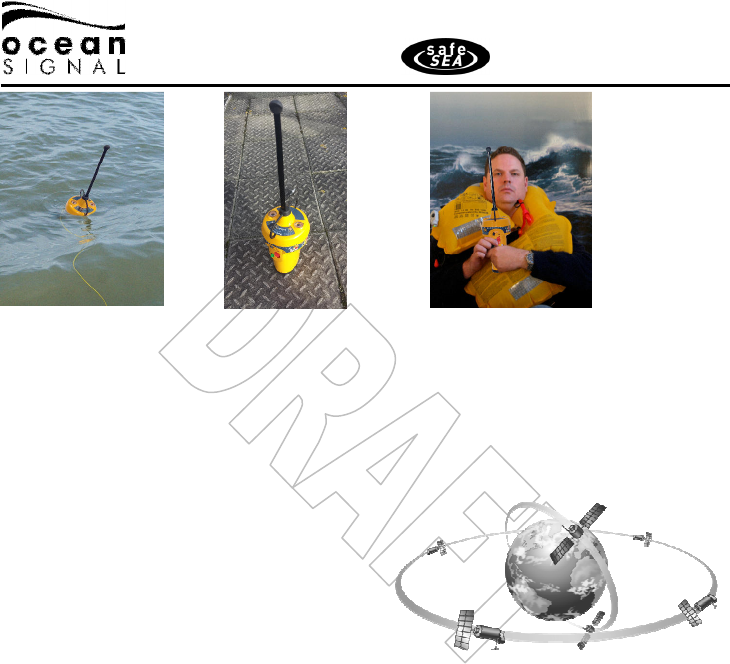
E101V USER MANUAL
6 Part No 912S-01865
a) EPIRB floating in
water
b) EPIRB deployed on
deck
c) EPIRB used in a
liferaft.
1.5 COSPAS/SARSAT System
The COSPAS/SARSAT system utilises two satellite arrays to provide distress alert and
location data to search and rescue authorities. The GEOSAR system can provide near
immediate alerting within the coverage of the receiving satellite. The LEOSAR system
provides coverage of the polar region beyond
the range of the GEOSAR system. It can
calculate the location of distress events using
Doppler processing techniques and is less
susceptible to obstructions which could block
a signal in a given direction. The system is
comprised of instruments on board the
satellites which detect the signals from the distress beacons. Ground receiving stations,
referred to as Local Users Terminals (LUTs) receive and process the satellite downlink
signal to generate the distress alerts. The distress alerts, generated by the LUTs, are then
received by Mission Control Centres (MCCs) which then forward the alert to Rescue Co-
ordination Centres (RCCs), Search and Rescue Points of Contacts (SPOCs) and other MCCs.
2. Installation
The E101V should be mounted where it is easily accessible in an emergency.
Do not mount the EPIRB closer than 1 metre to any steering compass as this may
affect the accuracy of the compass. Keep the EPIRB away from any strong magnetic
sources such as loudspeakers, compass compensation magnets, etc., which might
cause inadvertent activation.
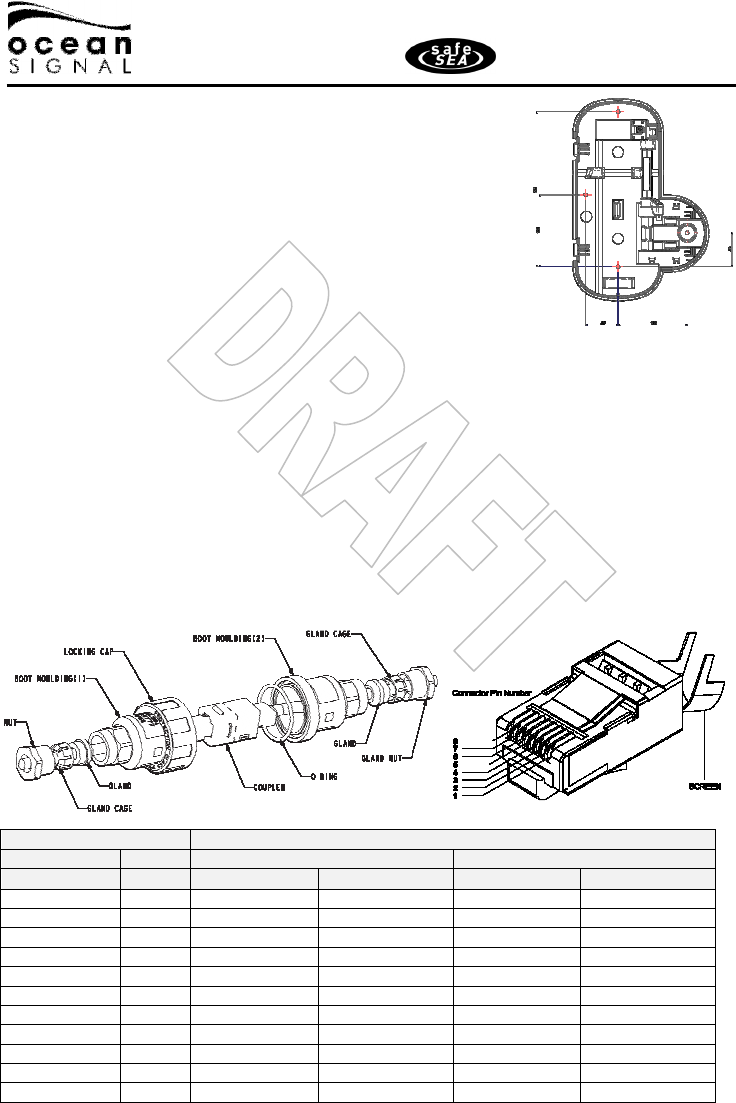
E101V USER MANUAL
7 Version 00.30 7/4/2016
2.1 VDR Installation
The E100V float free memory capsule should be mounted in an
external position where it will not be impeded when the float
free mechanism is automatically activated, irrespective of the
orientation of the vessel when it is sinking. The position should
be as high as possible on the vessel, but in a position where it
can still be accessed to manually release and test the E101V.
The ARH101 base should be mounted on a flat surface using
the four screws provided at the positions shown in the
dimensional drawing opposite.
2.1.1 VDR Connection
The E101V Float Free Capsule connects to the Main VDR system via a dedicated Ethernet
connection. Please consult the VDR manufacturers User and Installation Manuals for
further details of integration of the E101V with the VDR. The cable from the E101V housing
should be connected as described below. The E101V memory capsule is completely
isolated from the EPIRB battery and must be connected to either the ships supply (10.8-
31.2Volts DC) or Power Over Ethernet (POE). Please follow the connection diagrams
carefully to ensure correct operation.
•
Feed the cable from the ARH101 housing through the gland of one half of the supplied
waterproof cable housing and connect the RJ 45 connector as shown in the
accompanying table and diagram.
From Float Free
To VDR Network
ARH101
RJ45
POE
Ships Supply
Wire Colour
Pin
Wire Colour
Function
Wire Colour
Function
White/Orange 1 White/Orange Rx+ White/Orange Rx+
Orange 2 Orange Rx- Orange Rx-
White/Green 3 White/Green Tx+ White/Green Tx+
Blue 4 Blue DC+(POE) Do not connect
5 Do not connect Do not connect
Green 6 Green Tx- Green Tx-
7 Do not connect Do not connect
Brown 8 Brown DC-(POE) Do not connect
White/Blue - Do not connect White/Blue +ve (24V)
White/Brown - Do not connect White/Brown -ve (0V)
Screen Ground
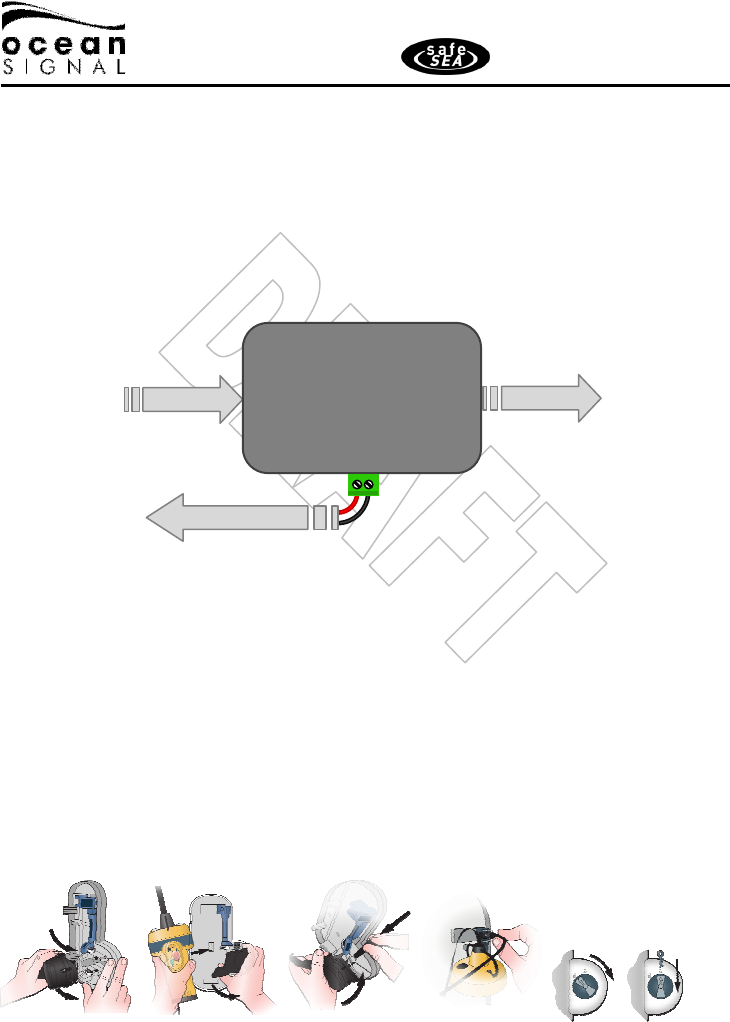
E101V USER MANUAL
8 Part No 912S-01865
•
Pass the cable from the ship’s network through the gland of the mating half and
connect to the RJ45 connector as shown for POE or ship’s supply options.
•
Connect the two cables through the joiner and mate the waterproof cable housing
together.
2.1.2 Ships Supply Connection
When connecting the E100V to the Ships supply, the included junction box must be
used. This is fitted close to the VDR network switch and connected as shown in the
diagram below, noting the polarity of the supply connections.
2.2 EPIRB Installation
•
Take the HRU and locate the two retaining ridges at the bottom of the HRU onto the
spring. Carefully push the HRU against the spring
•
Push the HRU into position as shown. Push the locking pin with the retaining flange
pointing down.
•
Pull the HRU up and load the EPIRB into the housing, ensuring it locates into the
upstand in the base. Gently release the HRU to lock the EPIRB in place.
•
Plug the network cable from the E100V into the socket in the base, being careful to line
the pins up correctly before pressing home.
•
Replace the housing cover, making sure the cable and antenna are neatly stowed.
Rotate the locking knob clockwise and insert the R-clip to lock it in place.
+V
0V
From VDR
To E101V
To Ships Supply
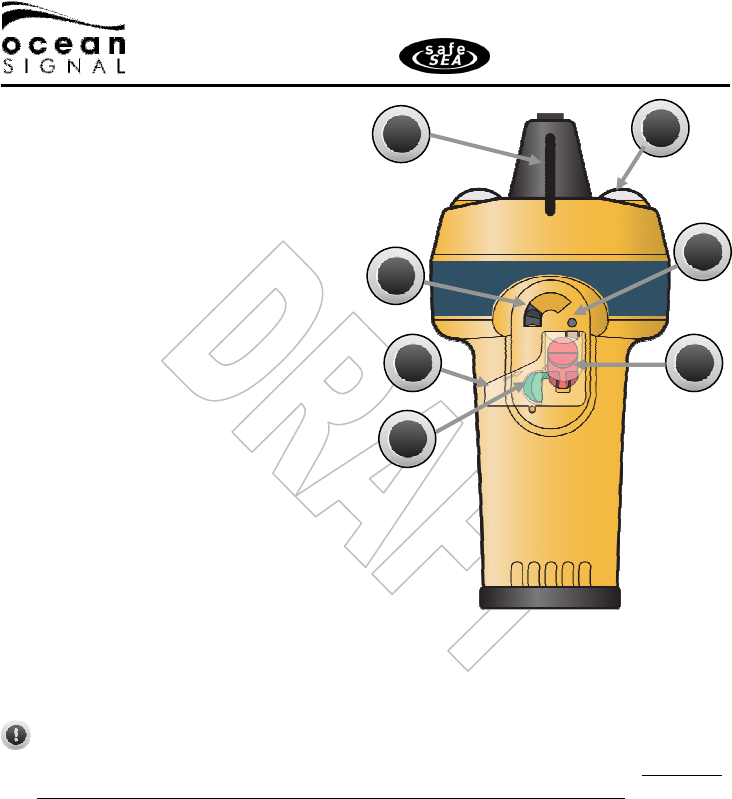
E101V USER MANUAL
9 Version 00.30 7/4/2016
3. E101V OVERVIEW
1) Grappling loops
2) Strobe lights
3) Test switch
4) Break off protective tab
5) Interlock switch
6) Indicator LED
7) Activation switch
* The lanyard on the rear of the EPIRB is provided to attach the EPIRB to the life raft or your person,
once it is activated. Do not use it to attach it to the ship, as this may result in the loss of the EPIRB if
the vessel sinks.
It is important that the vessel details are marked on the EPIRB. The MMSI, Vessel
Name and Call Sign are printed at the time of programming, where known. Cover this
label with the clear protective label provided to protect the text from wear.
2
1
3
4
5
6
7

E101V USER MANUAL
10 Part No 912S-01865
4. OPERATION
WARNING: USE ONLY IN SITUATIONS OF
GRAVE AND IMMINENT DANGER.
MISUSE MAY RESULT IN A SEVERE PENALTY
Ensure that your E101V is always fitted with an unused battery that is within the marked
expiry date. Failure to do so may result in reduced operating time when used in a real
emergency. Please observe the recommendations on testing in section 05.
4.1 Manual Release and Activation
Only activate your EPIRB in situations requiring emergency assistance from the
rescue authorities. Deliberate misuse of your EPIRB may result in a fine.
•
Remove the EPIRB by opening the auto release housing and remove
the EPIRB. Release the housing by pulling the locking R-Clip out of
knob pin. Press down and rotate the knob anti-clockwise to the
unlock position.
•
Remove the housing as shown
•
Release the hydrostatic release unit by pressing down and
removing the pin. Holding on to the EPIRB, pull the HRU away
until the spring is fully released. This will also pull the network
connector out of its socket. The EPIRB can now be activated.
•
To activate your EPIRB in an emergency, break off the clear
protective tab.
•
Slide and hold the Green switch to the left, then slide the RED switch into
the down position and release the Green switch

E101V USER MANUAL
11 Version 00.30 7/4/2016
•
During operation the green LED will flash once every five seconds while the GPS is
turned on and obtaining a fix. Once a fix is obtained, the green LED will flash quickly
three times.
•
Each time a 406MHz transmission is made the LED will flash quickly five times; green
for transmission with a GPS position and red for a transmission without a position.
•
The Red LED will flash every 2.5 seconds while the 121.5MHz homing beacon is active.
•
When operating the EPIRB in water, tether the beacon to your body or the liferaft.
•
Hold your beacon with the antenna standing vertically. Keep the area marked ‘GPS
Antenna’ free from obstruction, which would interfere with the GPS reception.
The EPIRB does not transmit an alert until approximately 50seconds has elapsed.
This allows time to deactivate the unit if accidentally turned on. The homing beacon
is not activated until after the first alert is sent.
4.2 Deactivation
To deactivate your EPIRB after use or if it is accidentally activated, push the green switch
to the left and slide the red switch fully upwards.
Should your EPIRB fail to deactivate using the red switch, fold up the antenna and
completely wrap the EPIRB in several layers of aluminium foil, or place it in a metal
container.
4.3 False Alerts
False alerts cause the rescue authorities unnecessary time and expense. To avoid false
alerts make sure your EPIRB is safely stowed in the automatic release housing with the
protective cover in place. Make sure that there is no excessive pressure applied to the
protective cover. Ensure that anybody carrying the EPIRB is fully aware that this device is
for emergencies and should only be used in situations of grave and imminent danger.
If you accidentally activate your beacon or otherwise set it off when a rescue is not
required, contact your local emergency services as soon as possible and advise them of
your beacon’s 15 digit HEX code (UIN), your current location and the time the beacon was
first activated.
For USA phone: 1-800-851-3051 (USAF Rescue Coordination Center)
For UK phone: +44 (0)1326 317575. (UKCG)

E101V USER MANUAL
12 Part No 912S-01865
5. TESTING
Routine testing of your EPIRB is recommended to ensure it is in good working order if
needed, but please follow the guidance notes below on the frequency that tests should be
carried out. Please remember that each test will reduce the battery capacity slightly and
reduce the operation time of your EPIRB during an emergency.
5.1 Beacon test
To test your E101V is functioning correctly, Rotate and hold the grey test key for one
second. The red LED will come on to indicate the switch is depressed, followed by the red
LED flashing rapidly, indicating test mode is activated. The switch may now be released.
The strobe light will flash once (indicating that the 406 and121.5MHz signal has been
transmitted). The indicator LED will flash green or amber to show a pass or red to show
fail status. The unit will automatically turn off.
Note: This status indication is repeated a
second time after a short delay.
The number of green/amber flashes in each group indicates the number of hours the
battery has been used for as shown in the table below.
Self Test Result Indicator
No of
Flashes
No of hours
used.
Green/Amber
Indicator
*
Type of
Failure
Red
indicator
1 Flash
0 to 1hr
(Green) 121.5MHz
homer
1 to 2hrs
(Amber)
2
Flashes
2 to 4hrs
(Amber)
406MHz
generation
3
Flashes
4 to 6hrs
(Amber)
406MHz
power
4
Flashes
6 to 8hrs
(Amber)
Faulty
battery
5
Flashes
8 to 10hrs
(Amber)
Other failure
6
Flashes
Over 10hrs
(Amber)
*
Changes to Amber after 1 hour of use
Because the test transmits a short burst on the
aircraft distress frequency of 121.5MHz, please
only carry out this test in the first five minutes of
each hour.
It is recommended to test your EPIRB once a
month.
The amber test result indicates the battery has
been used for over one hour or the allowed
number of tests has been exceeded. The EPIRB
will still operate normally in distress, but the
battery should be replaced to ensure the full
operating life when your EPIRB is needed.

E101V USER MANUAL
13 Version 00.30 7/4/2016
5.2 GPS test
Warning: as testing the GPS receiver expends significant amounts of battery energy do
not test the GPS operation more than once a year. Testing the GPS receiver is limited to
12 tests over the lifetime of the battery, after this the GPS test will fail to activate.
This test must only be performed where the EPIRB has a clear and unobstructed view of
the sky. This is required to allow the GPS receiver to acquire a signal from sufficient
satellites to allow it to determine a position. Make sure the area marked “GPS antenna”
is not obstructed.
Rotate and hold the TEST key for ten seconds. The LED will illuminate red to indicate the
key has been pressed then start flashing. Release the test key between 10 and 15 seconds.
If the TEST key is released before ten seconds, the EPIRB will enter the self test
mode.
If the TEST key is inadvertently held for over 15 seconds, the LED will start flashing
green. Release the TEST key and wait for 2 minutes before attempting another GPS
test
After entering the GPS test mode the LED will change to a long red flash and a short green
flash until either a position fix is obtained or the GPS test fails. A successful test will be
indicated by the strobe flashing and the green LED flashing. The number of green flashes
indicates the number of GPS tests remaining. The unit automatically turns off after the
test indication.
If after five minutes the GPS receiver has not received a position, a failure will be indicated
by the red LED flashing after which the unit will turn off.
The test can be ended at any time by rotating the TEST key for five seconds.
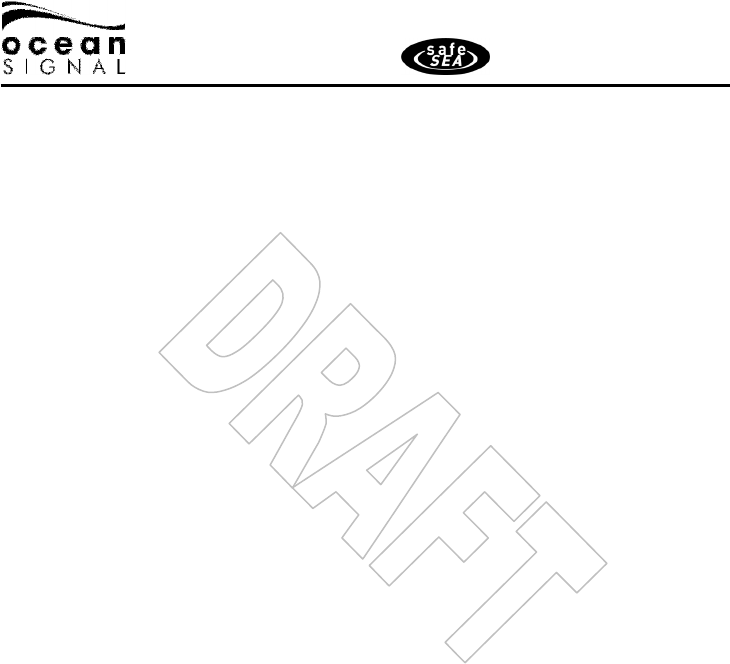
E101V USER MANUAL
14 Part No 912S-01865
6. APPENDIX
6.1 Maintenance and Troubleshooting
Your EPIRB will require little maintenance except periodic cleaning, if required. Always
use a damp cloth to clean the case and dry thoroughly. Do not use solvents or other
cleaning fluids as this may cause the plastics to deteriorate.
6.2 Batteries
The E101V contains Lithium batteries for long operating life. Your battery must be
replaced either after the expiry date or after the EPIRB has been activated for over one
hour. Battery replacement must be done at an Ocean Signal authorised battery
replacement centre.
All Lithium batteries self discharge slowly over time at a rate that is related to
temperature. Maximum performance of the battery is achieved with long term storage at
an average temperature of no greater than 20°C.
6.3 Transport
When shipping your EPIRB the following guidance and regulations should be followed, but
you are advised to contact your nearest battery replacement centre or Ocean Signal prior
to shipping as regulations may have changed.
•
Always pack your EPIRB securely in a stout cardboard carton. Ocean Signal advises
that you keep the original packaging in case of return for service.
•
For Road or Sea transport the E101V should be shipped as UN3091 packing instruction
903.
•
For air transport the E101V should be shipped as category UN3091 and packed under
IATA packing instruction 970 section 1.
6.4 Disposal
Care should be taken when disposing of your EPIRB when it is no longer required. It is
recommended to remove the battery from the EPIRB by removing the case lid. The case
screws are covered by the top labels. Dispose of the battery in accordance with local
waste regulations. Please note that the E101V is not user serviceable and removing the lid
will invalidate the warranty.

E101V USER MANUAL
15 Version 00.30 7/4/2016
6.5 HRU Replacement
If you have an EPIRB mounted in a float free housing, this will also contain a HR1E
Hydrostatic Release Unit (HRU). The HRU unit must be replaced two years after installation
- the expiry date is marked on the HRU and on the front of the housing. If this date has
been reached then the HRU must be replaced with an Ocean Signal HR1E, failure to do so
may result in the HRU not operating correctly during an emergency situation.
1. Lift the release mechanism by
pulling against the spring and
remove the EPIRB from the housing.
2. Push the HRU down against the
spring and remove the locking pin.
Carefully remove the HRU from the
spring.
3. Using the new HRU, locate the two
retaining ridges (at the bottom of the
HRU) onto the spring. Carefully push
the HRU against the spring.
4. Push the HRU into position as shown.
Push the locking pin home with the
retaining flange pointing down. Load
the EPIRB into the housing.
Mark the label on the HRU and the supplied label for fitting to the ARH101, with the expiry
date using a UV resistant indelible pen. The expiry date should be two years after the date
of installation, but no more than three years after the date of manufacture marked on the
HRU.
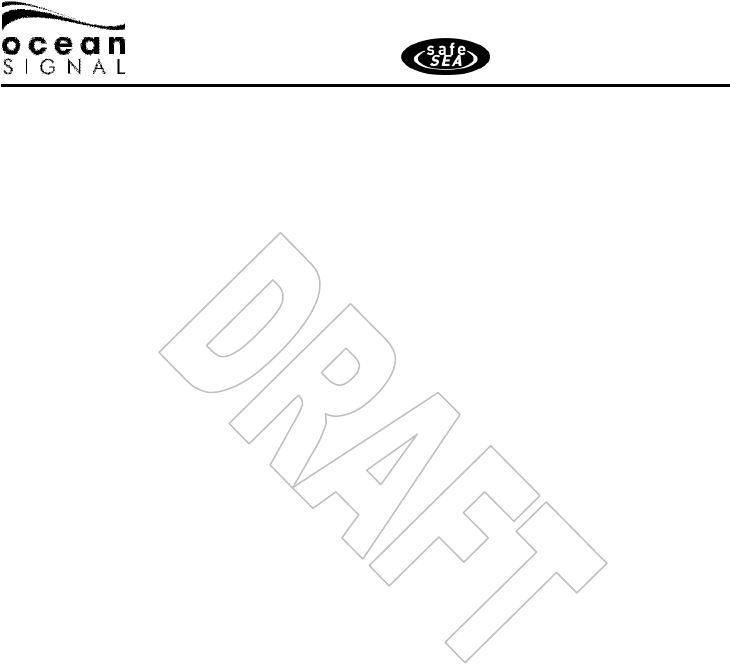
E101V USER MANUAL
16 Part No 912S-01865
6.6 Specifications
406MHz Transmitter
Frequency .......................................................................................................... 406.040 MHz ±1KHz
Output Power .................................................................................................................... 5W Typical
Modulation .................................................................................. Phase ±1.1 Radians Pk (16K0G1D)
Encoding ............................................................................................................................. Biphase L
Rate .........................................................................................................................................400 bps
121.5MHz Transmitter
Frequency ......................................................................................................................... 121.5 MHz
Output Power (PERP) ...................................................................................................... 40mW±2dB
Modulation .............................................................................................. Swept Tone AM (3K20A3X)
Modulation Depth ..................................................................................................................... ~97%
Frequency Stability ............................................................................................................... ±50ppm
Duty Cycle ................................................................................................................................. ~35%
Low Duty Cycle Strobe
Light Type .................................................................................................... Dual High Intensity LED
Flash Rate .............................................................................................................. 20-30 per minute
Battery
Type ........................................................................................ Lithium Manganese Dioxide (LiMnO2)
Operating ........................................................................................................... >168Hours @ -20°C
Battery Replacement Period ................................................................................................... 8years
GPS Receiver
Satellites Tracked ............................................................................................................ 66 Channel
Sensitivity ............................................................................................................................ -148dBm
Cold Start Re-acquisition ................................................................................................... -163dBm
GPS Antenna ........................................................................................................... Microstrip Patch
General
Weight ............................................................................................................................... 1006grams
Environmental
IEC60945 Category ............................................................................................................... Portable
Operating Temperature ................................................................................... Class 2 -20C to +55C
Storage Temperature ...................................................................................... Class 2 -30C to +70C
Waterproof ........................................................................................................................ 10m depth
Approvals
Cospas Sarsat standards ................................................................................................ T.001, T.007
Test standards ................................................................................................................. IEC61097-2

E101V USER MANUAL
17 Version 00.30 7/4/2016
6.7 Approvals
6.7.1 Marine Equipment Directive
The E101V is approved under the EU Marine Equipment Directive 96/98/EC as amended
under Annex A.1/5.6.
6.7.2 Industry Canada Approval
This device complies with Industry Canada licence-exempt RSS standard(s). Operation is
subject to the following two conditions: (1) this device may not cause interference, and (2)
this device must accept any interference, including interference that may cause undesired
operation of the device.
6.8 Registration
It is a legal requirement to register your EPIRB with your national authority. Failure to do
so may result in prosecution. Accurate registration will help the authorities if your EPIRB
is activated and may speed up your rescue.
To register your beacon, contact your national registration authority via post, email or
online. Provide your 15 digit HEX ID (UIN), 5 digit checksum if required, your contact
details and emergency contact information. Some countries also require additional
information such as boat type and identification or alternative emergency contacts.
For UK registrations go to:
www.gov.uk/406beacon
For USA registrations go to:
www.beaconregistration.noaa.gov/
For Australia go to:
www.amsa.gov.au/beacons
For New Zealand go to:
www.beacons.org.nz
Details of other authorities may be found at www.406registration.com.
It is important to make sure that registration details are kept up to date and that the
authority is advised of change of ownership or disposal of your EPIRB.
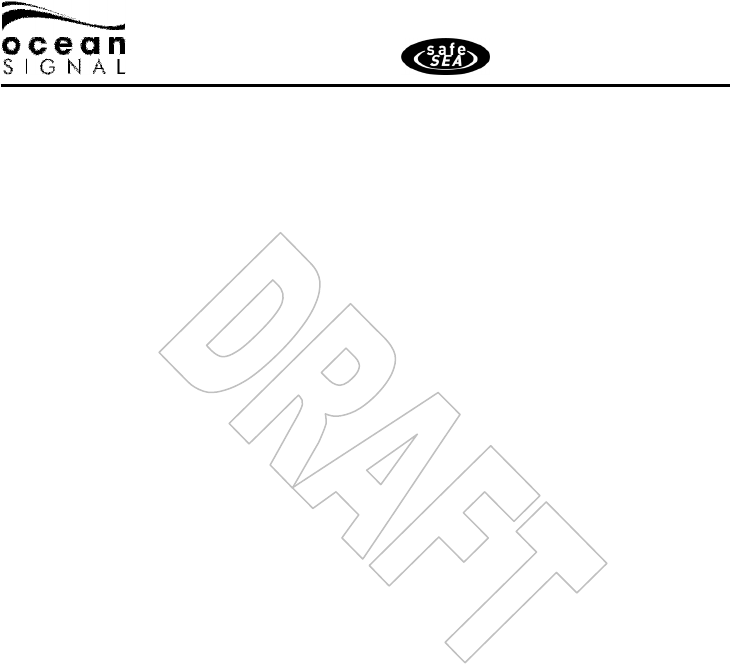
E101V USER MANUAL
18 Part No 912S-01865
6.9 Limited Warranty
Your Ocean Signal E101V is warranted against manufacturing defects in materials and
workmanship for a period of two years from the date of purchase and in accordance with
the following conditions.
Ocean Signal will at its discretion, repair or replace faulty product free of charge excluding
the cost of shipping. Proof of purchase shall be required in order for a warranty claim to
be valid from the original purchaser. All claims shall be made in writing to Ocean Signal or
an approved service dealer.
Ocean Signal shall not be liable to the buyer under the above warranty:
•
for any repairs or modifications carried out on the EPIRB using parts that are not
supplied or approved by the manufacture Ocean Signal including batteries and for work
carried out other than by Ocean Signal or approved service dealers,
•
for any part, material or accessory that is not manufactured by Ocean Signal the
consumer will be covered by the guarantee / warranty offered to Ocean Signal by the
manufacturer or supplier,
•
for product which has not been fully paid for,
•
for any product supplied by Ocean Signal to a customer under an alternative warranty
agreement,
•
for the cost of shipping product to and from the customer.
The battery is only warranted until the date of expiry and provided the unit is tested in
accordance with the information in the user manual. This warranty does not apply to a
used battery as indicated by the electronic witness (see page 8).
The following specific items are excluded from this warranty:
•
break off cover,
•
antenna,
•
network connector.
This warranty does not affect your statutory rights. This warranty is to be interpreted
under English law.
For further assistance please contact our Technical Service Department.
Email: service@oceansignal.com

E101V USER MANUAL
19 Version 00.30 7/4/2016
